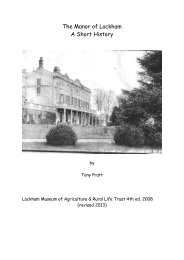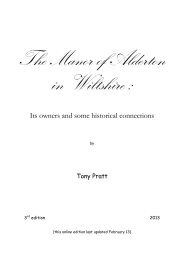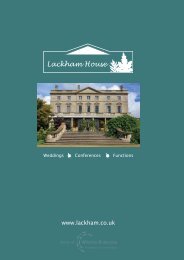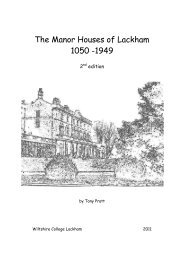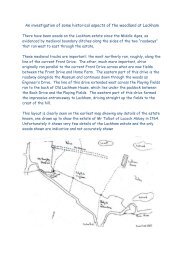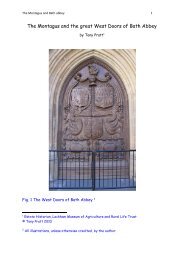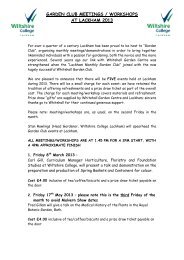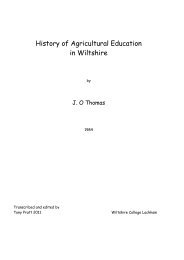Vol 1: The Bluets - Lackham Countryside Centre
Vol 1: The Bluets - Lackham Countryside Centre
Vol 1: The Bluets - Lackham Countryside Centre
You also want an ePaper? Increase the reach of your titles
YUMPU automatically turns print PDFs into web optimized ePapers that Google loves.
<strong>The</strong> <strong>Bluets</strong> 85<br />
on 24 th June 1287. This council was being headed by Earl Edmund because<br />
Edward I was in France, trying to settle disagreements over the ownership<br />
of Sicily. William was not the only Bluet involved this time; his son John<br />
Bluet was also in Wales in 1287, he was there with the Duke of Norfolk, his<br />
overlord for Silchester and <strong>Lackham</strong> 368. It is noteworthy that two <strong>Bluets</strong><br />
were called up – this hadn‘t even happened during the major invasion of<br />
Wales two years earlier. In the event it turned out this was because the<br />
regents, perhaps fearing a revolt on the scale of 1282-83 was imminent,<br />
responded with magnificent overreaction 369 and 24,000 men were<br />
mobilised. As it turned out this was not that serious a rebellion and was all<br />
over by the new year, but ap Maredudd remained at large until he was<br />
betrayed by four of his own men in April 1288. He was eventually hung and<br />
quartered at York. 370<br />
<strong>The</strong> Bluet‘s Wiltshire land was not confined to <strong>Lackham</strong>, of course; in<br />
common with the landowning patterns of the time there were parcels of<br />
land spread all over the county – for example William is recorded as<br />
holding a small amount of land 371 at Hurdecotes Ashton, somewhere<br />
between Semington and Westbury in Wiltshire from at least 1255 to<br />
1277. Other evidence that William owned land in many places can be<br />
found, if needed, in an agreement of 1282, where he acknowledged in<br />
Chancery that he owed Nicholas, son of Nicholas the treasurer of Wells,<br />
300 marks, and that this was to be levied on his lands in Wiltshire and<br />
Berkshire if he 372 failed to pay 373. This money was dowry so that<br />
Summons vol 1 p250<br />
368<br />
Calendar of Close Rolls Edw I 1282 – 1292 p274 ―John Bluet who is in Wales<br />
with the Duke of Norfolk until Michaelmas‖ dated Hereford 23 July<br />
128<br />
369<br />
Morris, M (2008) A Great and Terrible King : Edward I and the Forging of<br />
Britain Hutchinson London p217<br />
370<br />
Jenkins, GH (2006) A Concise History of Wales Cambridge p107<br />
371<br />
Victoria County History Wiltshire VIII p208. 2 carucates. <strong>The</strong> land was<br />
―probably‖ held from the barony of Castle Combe<br />
372<br />
Morris, M (2008) A Great and Terrible King : Edward I and the Forging of<br />
Britain Hutchinson London p217<br />
373<br />
Calendar Close Rolls Edw I vol 1 1279 – 1288 p 180 dated Friday after St Gegory<br />
1282. This would have been Friday the 13th of March, as the Feast of St Gregory<br />
(12 March) was on Thursday in 1282. This St. Gregory was the early Pope Gregory



